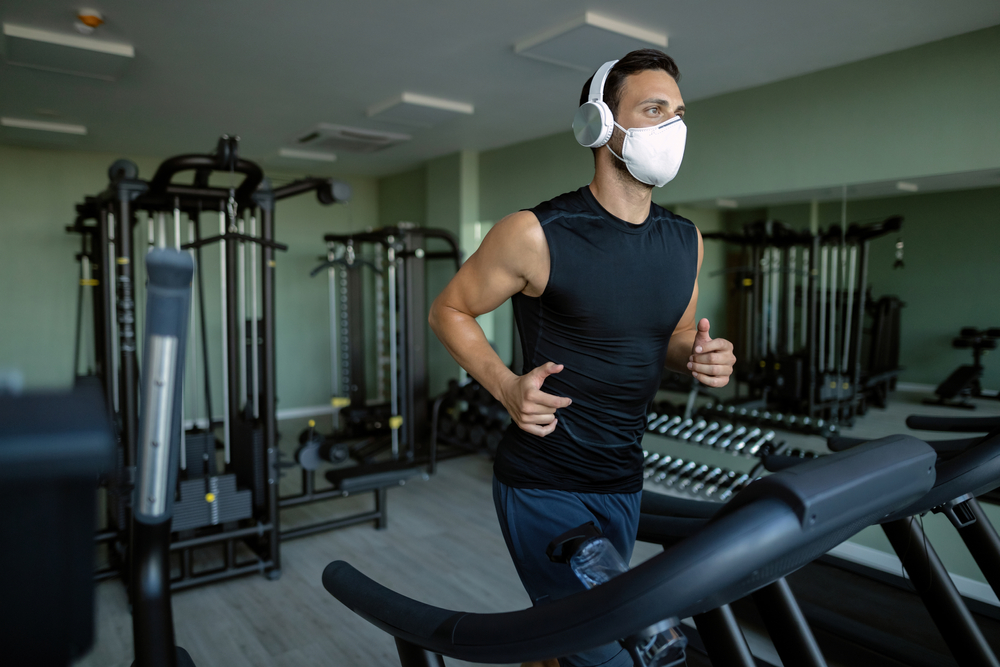
The COVID-19 pandemic has made it difficult for casual exercisers and athletes alike to get their workout in. Some people may be moving their workouts home, purchasing exercise equipment like (yoga mats, dumbbells, bands, pull-up bars, etc.) to get their work-out in from home, as well as fitness apps and online videos/classes. Others, now that many states are starting to loosen up public health recommendations in light of reduced COVID-19 new cases, are starting to make their way back to the gym.
Of course, gyms do not look the same as they always did. With physical distancing and mask mandate measures in place, gym-goers are seeking information about how safe it really is to exercise while wearing a face mask.
Face Masks And Exercise – How Safe Is It, Really?
Many people are worried that wearing a face mask while exercising will limit their oxygen flow, and could potentially lead to passing out and other bodily harm. An article published through ACE fitness, however, cites studies that show that working out with a face mask should be safe for most. One who chooses to wear one when working out should, however, closely self-monitor to see how their body is feeling. If one starts to feel dizzy, lightheaded, or over-exerted, they should cease exercise immediately and seek help. Being self-observant is an important skill to have when starting a workout routine with a face mask. Those who have respiratory or cardiac conditions already need to be cautioned when working out with a face mask, and should consult their doctor first and foremost.
Tips For Wearing A Face Mask While Exercising
- Monitor your intensity – if you have had an exercise routine for a while, you should already be aware of workouts that make you feel particularly exerted/out of breath. Since face masks do reduce oxygen flow, it is important to choose a workout that you can do safely. Consider swapping out your regular HIIT workout for something of lower intensity (e.g., a longer, less intense steady-state workout).
- Selecting the correct kind of face mask – scarves, bandanas, or rolled up t-shirts will not only fall off of your face easier, but they are also less effective in preventing COVID-19 infection. A well-fitting cloth mask is your best bet.
- Find the right fit – do some jumping jacks, burpees, jogging in place, or other exercises you engage in at the gym at home, wearing your mask. Does your mask feel way too tight? Does it slip below your mouth/nose, causing you to have to adjust constantly? If so, your face mask does not fit properly and should be swapped out with one that does.
- Clean your face mask after every use – this not only reduces COVID-19 infection risk but also promotes good personal hygiene.
What Kinds Of Workouts Can I Do?
If you are typically someone who exercises at a high intensity, consider the following swaps to lower the intensity of the exercise you are doing. However, with lower intensity exercise, keep in mind that you may be staying at the gym longer. If you enjoy your high-intensity routine, consider moving your workout outside or at home instead.
- Walking or jogging instead of running – running itself is a very high impact and high-intensity form of exercise. Reducing the intensity to a walk or light jog may help you be able to exercise safely in a mask.
- Swap Plyometrics for lower-impact – Plyometrics involves a lot of jumping. Swap Plyo moves for lower impact instead.
- HIIT intervals for steady-state – try maintaining a comfortable pace for your workout instead of doing HIIT intervals.
Overall, exercising while wearing a face mask is certainly possible and can be safe. However, it is important to make modifications and adjustments to ensure maximum safety for all.
